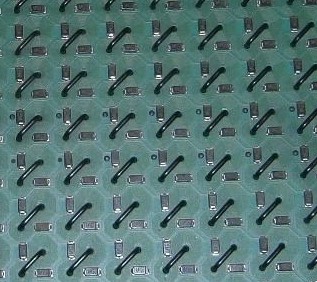I don't know when I'll receive my modules but I have found an online source of some Luminator Max 3000 arrays. 16 lines, 28 rows, this is perfect for my system. But how do we drive them ?
I've found a youtube video that seems to be a very similar model.
The implication is clear : it's a "typical" array, almost.
But there is a bit more than that, when looking closer.

We can see on the backside that there are 2 diodes per dot. So it's not a typical array like with LEDs. The solenoids must be driven in one direction or another, which is not the case with a classic diode array.
I have found an interesting description there http://electronics.stackexchange.com/questions/243030/how-to-drive-315-coills-in-flip-disc-display/243054 but I have independently come up with a little different approach that is suited to relay technology.

The +/-12V symmetric supply is already used for the DRAM bus of the #AMBAP: A Modest Bitslice Architecture Proposal but there is a difference : the column select switches to 0V, not -12V (which is required by the electrolytic polarized capacitors). The data driving circuit is shared with the data bus, but a separate column selector must be wired. A couple of diodes must also be added for each data line.
For semiconductor technology, it's quite simple as well : a high-side PNP or P-FET and a low-side NPN or N-FET will be enough, no need of a diode.
Of course, it must be tested.
PS: the diodes are not strictly required, if you drive one end with a high-side to +Vcc and the low-side to -Vcc. However the above circuit diagram requires the diodes because I get the data directly from the write bus of AMBAP. It already drives the data line at these levels to recharge the DRAM's capacitors. Without the diodes, the current wouldn't be correctly steered...
 Yann Guidon / YGDES
Yann Guidon / YGDES
Discussions
Become a Hackaday.io Member
Create an account to leave a comment. Already have an account? Log In.
I just tried to build a 5x8 array without the diodes installed. It turns out that if you don't have those diodes, there are current paths that will deliver nearlys as much current to solenoids in the same row/column as the target solenoid.
Are you sure? yes | no
Flip-dots are pretty-durn-cool!
Erm... Maybe too much coffee... But are the diodes at the relay's output necessary?
And, actually, why are there diodes in the array, anyhow?
Are you sure? yes | no
For the last question:
The array might be used in unipolar mode, with a single power supply. You have to let the current flow in both directions through the coil but only those that are selected.
The first question forces me to think and I have no brainjuice left to squeeze today, it's all gone with the GoL equations...
Are you sure? yes | no
whoa, I did look at that before, but I didn't catch that the diodes (D1, D2) are opposite directions than e.g. D3/D4.
And K1, wtf is that for?!
This thing's boggling my mind.
Are we sure the diodes are there for anything other than flyback-suppression?
Are you sure? yes | no
K1 is funky, I know... re-read the thread at http://electronics.stackexchange.com/questions/243030/how-to-drive-315-coills-in-flip-disc-display/243054
I don't think the diodes are for freewheeling. A small capacitor would usually be enough.
Are you sure? yes | no
This seems extremely convoluted to me... Note also that the original poster on that thread claims that each dot has its own input, so they're not arranged in rows/cols, unlike the video you embedded.
Your circuit seems a lot more intuitive, but I wonder what happens when two rows are driven opposite polarities, and the column-switch is not closed...
Are you sure? yes | no
I didn't catch the detail that the stackexchange example was not a matrix.
For the question about the array, my mental simulations tell me it's OK, I will hopefully know for sure in a few weeks ;-)
Are you sure? yes | no